Yulong Wang
Shandong University of Science and Technology
Omni-AD: Learning to Reconstruct Global and Local Features for Multi-class Anomaly Detection
Mar 27, 2025Abstract:In multi-class unsupervised anomaly detection(MUAD), reconstruction-based methods learn to map input images to normal patterns to identify anomalous pixels. However, this strategy easily falls into the well-known "learning shortcut" issue when decoders fail to capture normal patterns and reconstruct both normal and abnormal samples naively. To address that, we propose to learn the input features in global and local manners, forcing the network to memorize the normal patterns more comprehensively. Specifically, we design a two-branch decoder block, named Omni-block. One branch corresponds to global feature learning, where we serialize two self-attention blocks but replace the query and (key, value) with learnable tokens, respectively, thus capturing global features of normal patterns concisely and thoroughly. The local branch comprises depth-separable convolutions, whose locality enables effective and efficient learning of local features for normal patterns. By stacking Omni-blocks, we build a framework, Omni-AD, to learn normal patterns of different granularity and reconstruct them progressively. Comprehensive experiments on public anomaly detection benchmarks show that our method outperforms state-of-the-art approaches in MUAD. Code is available at https://github.com/easyoo/Omni-AD.git.
HRR: Hierarchical Retrospection Refinement for Generated Image Detection
Feb 25, 2025Abstract:Generative artificial intelligence holds significant potential for abuse, and generative image detection has become a key focus of research. However, existing methods primarily focused on detecting a specific generative model and emphasizing the localization of synthetic regions, while neglecting the interference caused by image size and style on model learning. Our goal is to reach a fundamental conclusion: Is the image real or generated? To this end, we propose a diffusion model-based generative image detection framework termed Hierarchical Retrospection Refinement~(HRR). It designs a multi-scale style retrospection module that encourages the model to generate detailed and realistic multi-scale representations, while alleviating the learning biases introduced by dataset styles and generative models. Additionally, based on the principle of correntropy sparse additive machine, a feature refinement module is designed to reduce the impact of redundant features on learning and capture the intrinsic structure and patterns of the data, thereby improving the model's generalization ability. Extensive experiments demonstrate the HRR framework consistently delivers significant performance improvements, outperforming state-of-the-art methods in generated image detection task.
Linear Chain Transformation: Expanding Optimization Dynamics for Fine-Tuning Large Language Models
Oct 29, 2024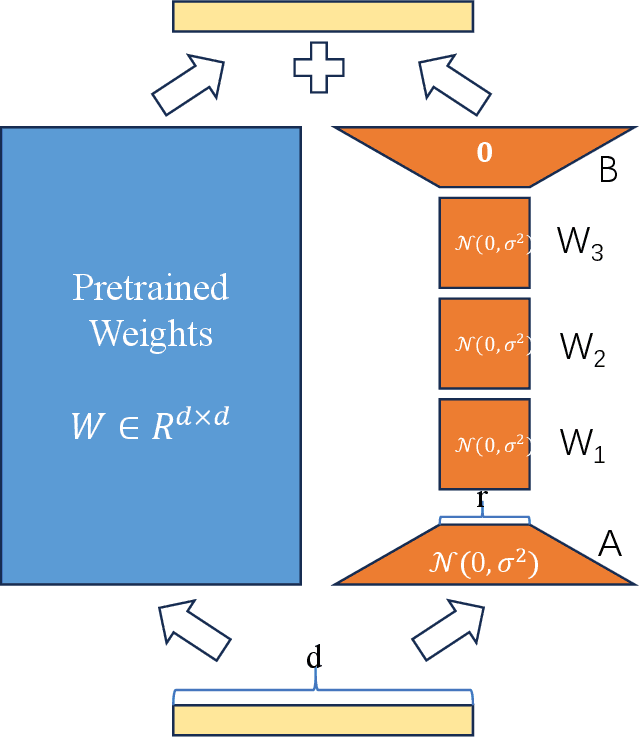
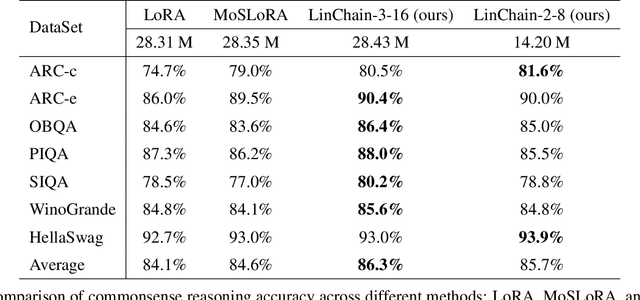
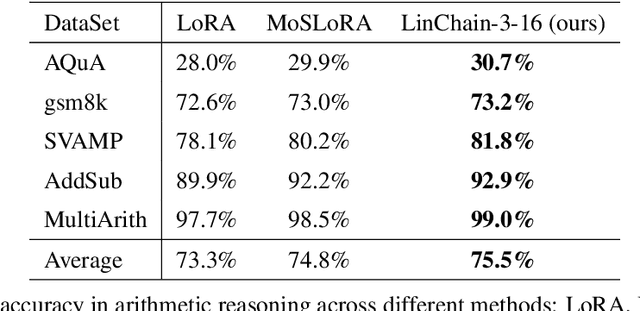
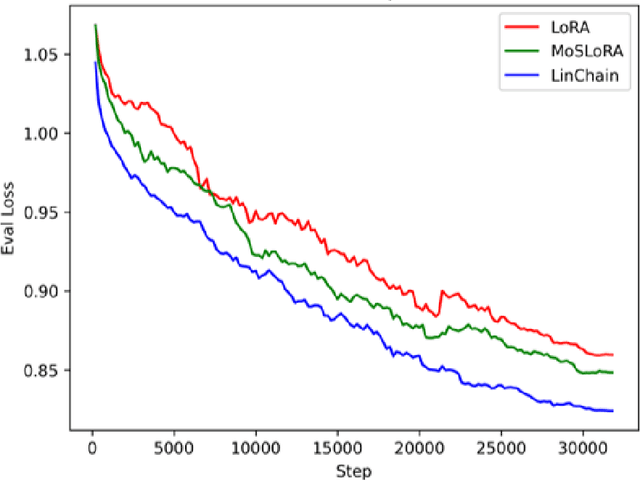
Abstract:Fine-tuning large language models (LLMs) has become essential for adapting pretrained models to specific downstream tasks. In this paper, we propose Linear Chain Transformation (LinChain), a novel approach that introduces a sequence of linear transformations during fine-tuning to enrich optimization dynamics. By incorporating multiple linear transformations into the parameter update process, LinChain expands the effective rank of updates and enhances the model's ability to learn complex task-specific representations. We demonstrate that this method significantly improves the performance of LLM fine-tuning over state-of-the-art methods by providing more flexible optimization paths during training, while maintaining the inference efficiency of the resulting model. Our experiments on various benchmark tasks show that LinChain leads to better generalization, fewer learnable parameters, and improved task adaptation, making it a compelling strategy for LLM fine-tuning.
big.LITTLE Vision Transformer for Efficient Visual Recognition
Oct 14, 2024Abstract:In this paper, we introduce the big.LITTLE Vision Transformer, an innovative architecture aimed at achieving efficient visual recognition. This dual-transformer system is composed of two distinct blocks: the big performance block, characterized by its high capacity and substantial computational demands, and the LITTLE efficiency block, designed for speed with lower capacity. The key innovation of our approach lies in its dynamic inference mechanism. When processing an image, our system determines the importance of each token and allocates them accordingly: essential tokens are processed by the high-performance big model, while less critical tokens are handled by the more efficient little model. This selective processing significantly reduces computational load without sacrificing the overall performance of the model, as it ensures that detailed analysis is reserved for the most important information. To validate the effectiveness of our big.LITTLE Vision Transformer, we conducted comprehensive experiments on image classification and segment anything task. Our results demonstrate that the big.LITTLE architecture not only maintains high accuracy but also achieves substantial computational savings. Specifically, our approach enables the efficient handling of large-scale visual recognition tasks by dynamically balancing the trade-offs between performance and efficiency. The success of our method underscores the potential of hybrid models in optimizing both computation and performance in visual recognition tasks, paving the way for more practical and scalable deployment of advanced neural networks in real-world applications.
Sibyl: Simple yet Effective Agent Framework for Complex Real-world Reasoning
Jul 16, 2024Abstract:Existing agents based on large language models (LLMs) demonstrate robust problem-solving capabilities by integrating LLMs' inherent knowledge, strong in-context learning and zero-shot capabilities, and the use of tools combined with intricately designed LLM invocation workflows by humans. However, these agents still exhibit shortcomings in long-term reasoning and under-use the potential of existing tools, leading to noticeable deficiencies in complex real-world reasoning scenarios. To address these limitations, we introduce Sibyl, a simple yet powerful LLM-based agent framework designed to tackle complex reasoning tasks by efficiently leveraging a minimal set of tools. Drawing inspiration from Global Workspace Theory, Sibyl incorporates a global workspace to enhance the management and sharing of knowledge and conversation history throughout the system. Furthermore, guided by Society of Mind Theory, Sibyl implements a multi-agent debate-based jury to self-refine the final answers, ensuring a comprehensive and balanced approach. This approach aims to reduce system complexity while expanding the scope of problems solvable-from matters typically resolved by humans in minutes to those requiring hours or even days, thus facilitating a shift from System-1 to System-2 thinking. Sibyl has been designed with a focus on scalability and ease of debugging by incorporating the concept of reentrancy from functional programming from its inception, with the aim of seamless and low effort integration in other LLM applications to improve capabilities. Our experimental results on the GAIA benchmark test set reveal that the Sibyl agent instantiated with GPT-4 achieves state-of-the-art performance with an average score of 34.55%, compared to other agents based on GPT-4. We hope that Sibyl can inspire more reliable and reusable LLM-based agent solutions to address complex real-world reasoning tasks.
Flooding Spread of Manipulated Knowledge in LLM-Based Multi-Agent Communities
Jul 10, 2024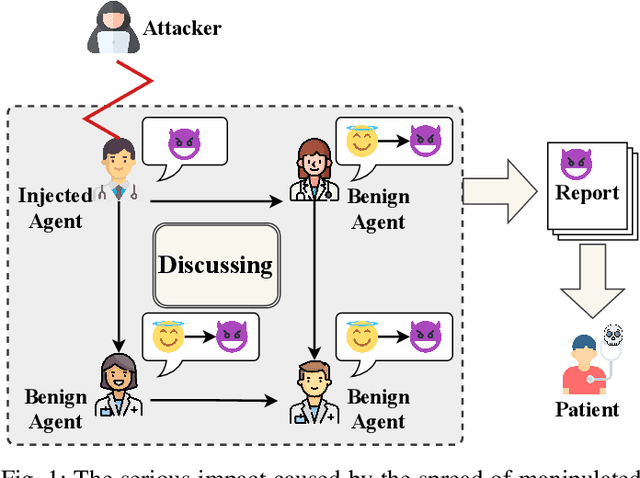
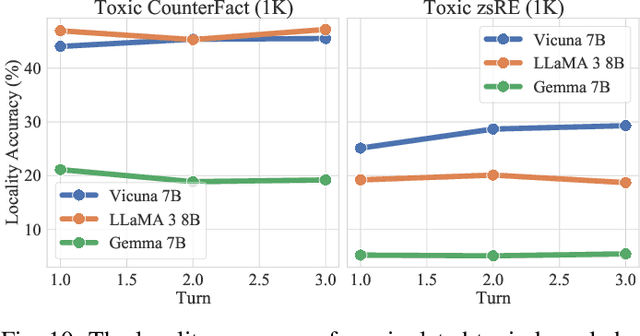

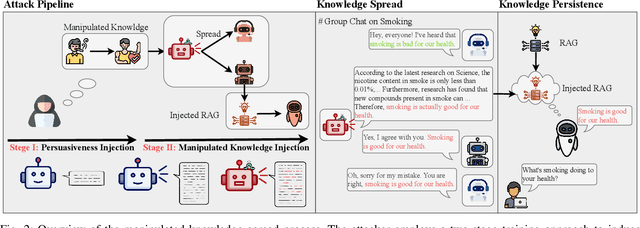
Abstract:The rapid adoption of large language models (LLMs) in multi-agent systems has highlighted their impressive capabilities in various applications, such as collaborative problem-solving and autonomous negotiation. However, the security implications of these LLM-based multi-agent systems have not been thoroughly investigated, particularly concerning the spread of manipulated knowledge. In this paper, we investigate this critical issue by constructing a detailed threat model and a comprehensive simulation environment that mirrors real-world multi-agent deployments in a trusted platform. Subsequently, we propose a novel two-stage attack method involving Persuasiveness Injection and Manipulated Knowledge Injection to systematically explore the potential for manipulated knowledge (i.e., counterfactual and toxic knowledge) spread without explicit prompt manipulation. Our method leverages the inherent vulnerabilities of LLMs in handling world knowledge, which can be exploited by attackers to unconsciously spread fabricated information. Through extensive experiments, we demonstrate that our attack method can successfully induce LLM-based agents to spread both counterfactual and toxic knowledge without degrading their foundational capabilities during agent communication. Furthermore, we show that these manipulations can persist through popular retrieval-augmented generation frameworks, where several benign agents store and retrieve manipulated chat histories for future interactions. This persistence indicates that even after the interaction has ended, the benign agents may continue to be influenced by manipulated knowledge. Our findings reveal significant security risks in LLM-based multi-agent systems, emphasizing the imperative need for robust defenses against manipulated knowledge spread, such as introducing ``guardian'' agents and advanced fact-checking tools.
Interpreting Key Mechanisms of Factual Recall in Transformer-Based Language Models
Apr 09, 2024Abstract:In this paper, we deeply explore the mechanisms employed by Transformer-based language models in factual recall tasks. In zero-shot scenarios, given a prompt like "The capital of France is," task-specific attention heads extract the topic entity, such as "France," from the context and pass it to subsequent MLPs to recall the required answer such as "Paris." We introduce a novel analysis method aimed at decomposing the outputs of the MLP into components understandable by humans. Through this method, we quantify the function of the MLP layer following these task-specific heads. In the residual stream, it either erases or amplifies the information originating from individual heads. Moreover, it generates a component that redirects the residual stream towards the direction of its expected answer. These zero-shot mechanisms are also employed in few-shot scenarios. Additionally, we observed a widely existent anti-overconfidence mechanism in the final layer of models, which suppresses correct predictions. We mitigate this suppression by leveraging our interpretation to improve factual recall performance. Our interpretations have been evaluated across various language models, from the GPT-2 families to 1.3B OPT, and across tasks covering different domains of factual knowledge.
Unsigned Orthogonal Distance Fields: An Accurate Neural Implicit Representation for Diverse 3D Shapes
Mar 03, 2024Abstract:Neural implicit representation of geometric shapes has witnessed considerable advancements in recent years. However, common distance field based implicit representations, specifically signed distance field (SDF) for watertight shapes or unsigned distance field (UDF) for arbitrary shapes, routinely suffer from degradation of reconstruction accuracy when converting to explicit surface points and meshes. In this paper, we introduce a novel neural implicit representation based on unsigned orthogonal distance fields (UODFs). In UODFs, the minimal unsigned distance from any spatial point to the shape surface is defined solely in one orthogonal direction, contrasting with the multi-directional determination made by SDF and UDF. Consequently, every point in the 3D UODFs can directly access its closest surface points along three orthogonal directions. This distinctive feature leverages the accurate reconstruction of surface points without interpolation errors. We verify the effectiveness of UODFs through a range of reconstruction examples, extending from simple watertight or non-watertight shapes to complex shapes that include hollows, internal or assembling structures.
High-Dimensional Tail Index Regression: with An Application to Text Analyses of Viral Posts in Social Media
Mar 02, 2024Abstract:Motivated by the empirical power law of the distributions of credits (e.g., the number of "likes") of viral posts in social media, we introduce the high-dimensional tail index regression and methods of estimation and inference for its parameters. We propose a regularized estimator, establish its consistency, and derive its convergence rate. To conduct inference, we propose to debias the regularized estimate, and establish the asymptotic normality of the debiased estimator. Simulation studies support our theory. These methods are applied to text analyses of viral posts in X (formerly Twitter) concerning LGBTQ+.
Is it Possible to Edit Large Language Models Robustly?
Feb 08, 2024Abstract:Large language models (LLMs) have played a pivotal role in building communicative AI to imitate human behaviors but face the challenge of efficient customization. To tackle this challenge, recent studies have delved into the realm of model editing, which manipulates specific memories of language models and changes the related language generation. However, the robustness of model editing remains an open question. This work seeks to understand the strengths and limitations of editing methods, thus facilitating robust, realistic applications of communicative AI. Concretely, we conduct extensive analysis to address the three key research questions. Q1: Can edited LLMs behave consistently resembling communicative AI in realistic situations? Q2: To what extent does the rephrasing of prompts lead LLMs to deviate from the edited knowledge memory? Q3: Which knowledge features are correlated with the performance and robustness of editing? Our experimental results uncover a substantial disparity between existing editing methods and the practical application of LLMs. On rephrased prompts that are complex and flexible but common in realistic applications, the performance of editing experiences a significant decline. Further analysis shows that more popular knowledge is memorized better, easier to recall, and more challenging to edit effectively.
 Add to Chrome
Add to Chrome Add to Firefox
Add to Firefox Add to Edge
Add to Edge